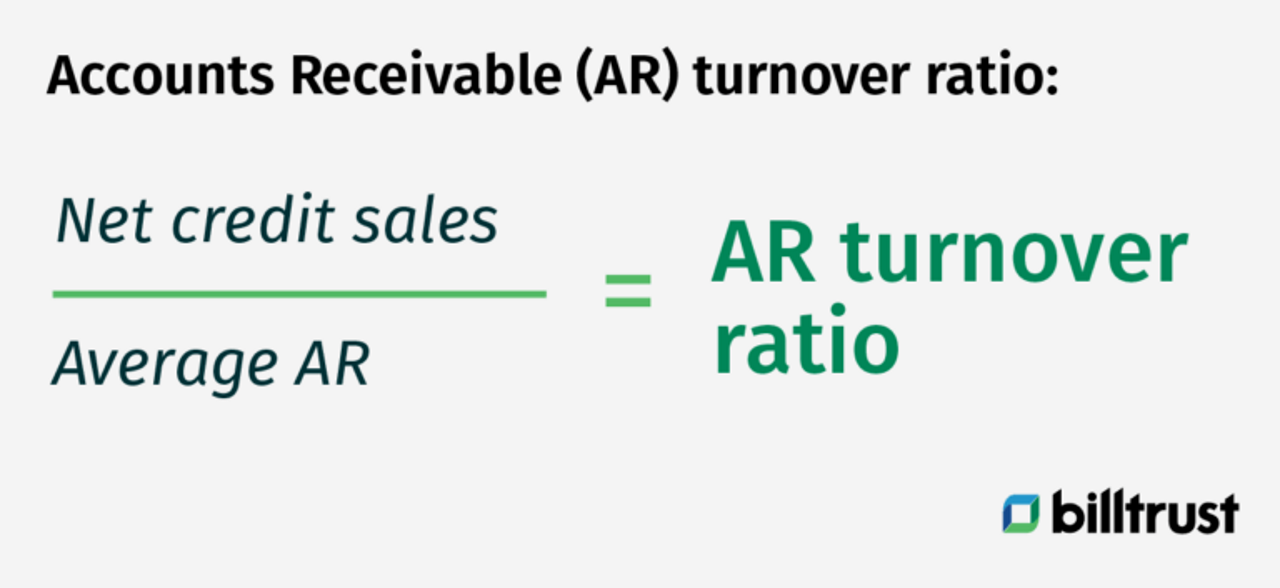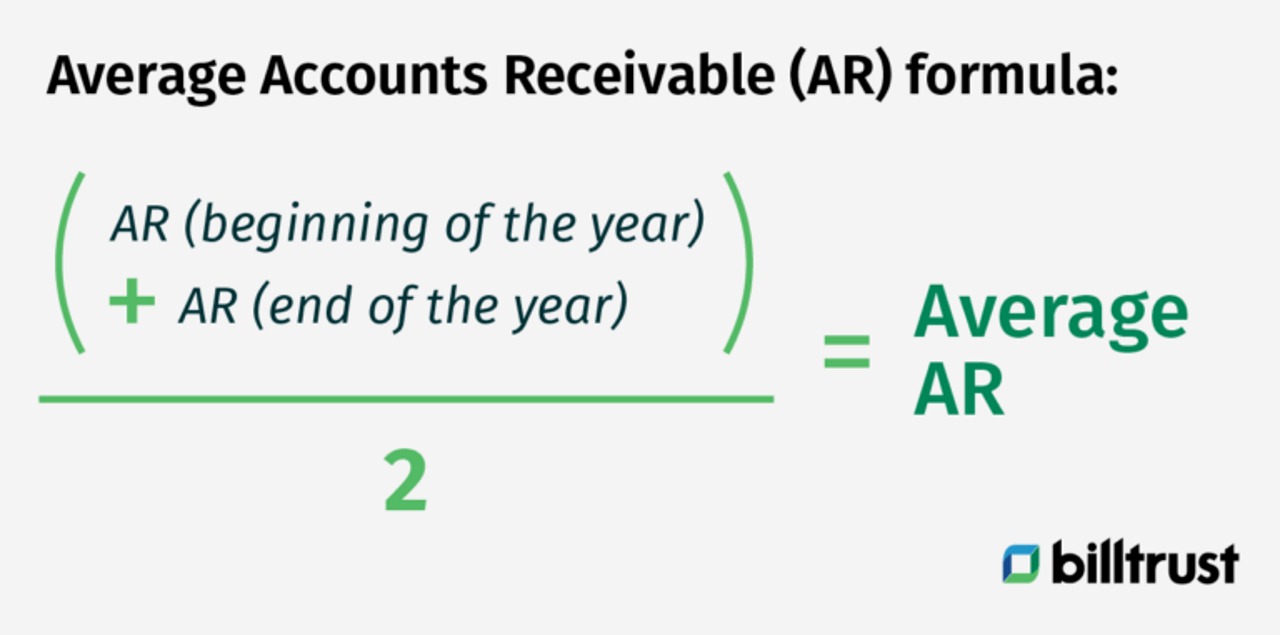The accounts receivable turnover ratio measures the number of times a company converts its outstanding receivables to cash in a given period. Accounts receivable turnover is measured in monthly, quarterly, and annual periods. Accounts receivable turnover is an essential metric for measuring how fast a company can get the money it is owed by its customers.
Accounts receivable turnover is usually expressed as a ratio of annual credit sales to average accounts receivable balance. This number measures how many times on average the company can "turn over" (collect) its total receivables each year. The higher the ratio, the more quickly a company can turn over its total receivables. This number has an inverse relationship with the days in accounts receivable.
Accounts receivable turnover formula
The accounts receivable turnover formula is used to calculate the number of times an account will be paid. In many cases, the best way to avoid bad debt is by turning receivables over faster. This decreases the company’s risk for a bad debt loss.
The accounts receivable turnover formula is:

Accounts receivable turnover (A/R) can be calculated by dividing the Net Credit Sales (CR) by the Average Account Receivables (AR).
Note: Average Accounts receivable = the starting and ending accounts receivable sums over a given time (such as quarterly or monthly), divided by 2.

Net credit sales are cash to be collected later. Net credit sales = Credit sales - Sales returns - Sales allowances.

The higher the account receivables turnover ratio, the faster a company converts credit to cash. A high ratio also means that the receivables are more likely to be paid in full.
Accounts receivable turnover calculation example
The accounts receivable turnover ratio is a financial ratio that measures the number of times a company's accounts receivable (AR) are collected in one accounting period.
Check out a real-world example of how you can calculate accounts receivable turnover below:
Suppose a company's accounts receivable (AR) collection period is monthly.
The beginning accounts receivable balance within a single accounting period is $500,000, and the ending balance is $585,000.
Then, $500,000 + $585,000 = $1,085,000 ÷ 2 = $542,500, which is the net accounts receivable balance.
Next, take the net credit sales for the accounting period and divide it by the net accounts receivable balance to determine the ratio.
Suppose this hypothetical company's net credit sales are $5,000,000.
Divide this number by the net accounts receivable value to determine the accounts receivable turnover ratio.
$5,000,000 ÷ $542,500 = 9.216
Thus, 9.2 is this business’s accounts receivable turnover ratio.
Accounts receivable turnover in days calculation example
A business can decrease its receivable turnover time by using a "360-day" calculation instead. A "360-day" calculation is one way of calculating receivable turnover time. Essentially, this is the number of days from when a customer's invoice was delivered to them until paid in full.
How can you calculate this turnover?
Receivable turnover in days = 365 / Receivable turnover ratio
365 / 9.2 = 39.673
Or use "360" for an accounting year. However, there isn't that much of a difference.
360 / 9.2 = 39.13
The "360-day" calculation is designed to decrease the company's receivable turnover time by ending the process at 360 days. This allows the company to make it through a full year of billing cycles while maintaining its profit. This way, businesses can more accurately plan for future optimized cash flows, make better payroll, improve their credit management, and inventory management decisions.
Accounts receivable turnover interpretation
The accounts receivable turnover formula provides a snapshot of a company's cash flow. Most companies take anywhere from 30 to 60 days for sales to turn into cash when using traditional methods like issuing invoices and collecting payments. However, suppliers can reduce this time frame significantly by making customers pay when goods are delivered or services are rendered.
The goal of this metric is to show how many times a year your company collects on its customer debt, which will help indicate whether it should push debt collection efforts or shorten the credit terms they offer customers.

The result can be interpreted as:
- The number of times per year that a company collects on its debts.
- A measure of how fast a company is paid by its customers.
- The rate at which a company sells its products or services per year compared with the rate at which it collects on those sales.
The higher the accounts receivable turnover, the better it is for the company. When accounts receivables are paid off quickly, there are fewer bad debts. This means less risk for the company because they have money coming in for their other expenses.
In recent years, accounts receivable turnover has increased globally due to technological advances that have made it easier for customers across borders to make purchases online without incurring additional costs. AR automation is also a strategic player in the streamlining process. As a result, you can think of accounts receivable turnover as a gauge of how fast a company converts credit into cash.
What is a good accounts receivable turnover ratio?
In accounting, the accounts receivable turnover ratio measures how well a company manages its credit risk from its customers. This ratio tells how many times an organization can get its outstanding invoices paid off in one year.
However, the accounts receivable turnover ratio interpretation is not as straightforward as one might think. The accounts receivable turnover does not simply measure how efficiently a business collects its outstanding debts. It also depends on how quickly new sales are being made. If the credit terms are too generous, it can impact the company’s cash flow and profitability.
The higher the accounts receivable turnover ratio, the more efficiently the organization collects past due debts. This ratio is often measured in times per annum and can also be used to assess a company's creditworthiness.
How do you maintain a high accounts receivable turnover ratio?
A good cash flow management strategy is crucial to monitoring your current cash position and will ensure that you maintain the high accounts receivable turnover ratio you need to solidify successful debt collection and overall creditworthiness.
Optimizing accounts receivable turnover rates
Optimizing your accounts receivable turnover rate is the key to boosting cash flow. A company with a higher turnover rate generally has more stable cash flow and is in better financial health than one with a lower turnover rate. This high accounts receivable turnover rate means less time for a company to turn over its money.
How can you improve your accounts receivable turnover rates?
As you optimize your accounts receivable turnover rates, look at the balance between the ratio of receivables to payables:
- If this ratio is high, it suggests that the company has an unfavorable business credit rating. It also indicates that there are restrictions on the company’s ability to borrow funds.
- The other balance is between inventory turnover and accounts receivable turnover. The faster you can turn over your inventory, the faster your revenue comes in.
The bottom line?
Optimizing your accounts receivable turnover rate could mean saving a significant amount of money overall.

